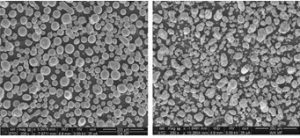Technical Newsletter vol.28 : Powder difference by powder manufacturing methods
Powder difference by powder manufacturing methods
In this newsletter we introduce the differences of metal powder used for MIM component production. In Vol. 11, we talked about titanium powder and this time ferrous powder or stainless-steel powder, which is the most popularly applied in metal injection moulding or MIM production, will be discussed.
Required specifications for MIM powder
An average powder distribution size (D50) of 10 μm is commonly deployed in the metal injection moulding (MIM) market, which is a smaller range in the powder metallurgy industry. Additionally, the shape of the powder itself also affects the productivity; thus spherical small powder is the most favorable powder specification in metal injection moulding. The atomisation process can be separated in 2 types according to the cooling media, water or gas atomised powder. In case of titanium powder, the reactivity to oxygen in water, elevated temperature is extremely high thus, water gas atomisation is not applied. However, ferrous powders, especially the stainless-steel powders are produced in water atomisation method. The water atomisation of stainless-steel production has been researched and developed since the 1950s.
The difference between water & gas atomised powder
These SEM images are gas atomised (left) and water atomised (right) powder. As shown in the images, the powder size is almost the same, but the shape is different.

Figure SEM images of gas (left) and water atomised powder (right) of low alloy steel powder (https://doi.org/10.1016/j.addma.2020.101675)
The water atomised powder has higher oxygen content and more variety of the powder shape; thus it is said that the water atomised powder is not suitable for metal additive manufacturing use. However, the water atomised powder is recapturing attention for stable and low production cost, due to the increasing price of noble gas which is crucial in gas atomised powder production. Additionally, the cooling rate of the water atomisation is much faster than the gas atomisation. Therefore, water atomisation getting more attention for amorphous alloy, new composition stainless steel or other microstructure control required alloy powder production.
Atomised powder future
The production capacity of atomised metal powder is increasing all over the world to meet the increased demand from the additive manufacturing industry. The metal powder manufacturers have invested in the latest atomisation facilities which realise high productivity and quality at the same time. It is easier to purchase high quality atomised powder than a few years ago. Thus, we believe that requirements for our micro metal injection moulding or (μ-MIM®) technology application will increase more and more. If you are considering mass-production of your small complicated designed metal components, please contact us.
References
https://doi.org/10.1016/j.addma.2020.101675
https://www.pim-international.com/powder-injection-moulding-international-magazine-archive/pim-international-vol-13-no-1-march-2019/
http://www.atmix.co.jp/pdf/201014.pdf
COLUMN

I am Ryoichi Wada who joined last summer in the R&D department. Both in my previous position as well as in my study I specialised in polymers. My mission in terms of work is “enjoy work as well! and I aim to be a person who can support the team behind the scenes like the binder in MIM process. I love to learn new things, and my current hobby is to create a delicious meal with seasonal ingredients by putting my energy x time x catalyst (spices). I was happy that I managed to make a tasty pasta dish with firefly squid and rape flowers, which are in season now.
